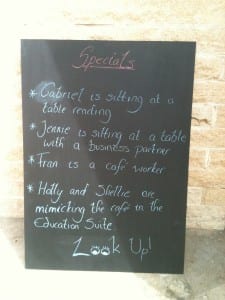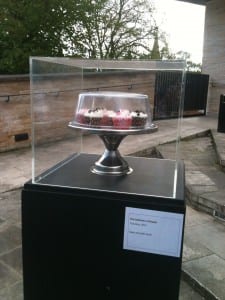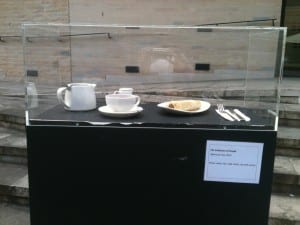After finally performing our piece the other day, I have mixed feelings as to whether it was a success. On the whole I think it went well and enjoyed being a part of the group and my part in the performance. However, if we were to do it again, I think improvements could be made.
Considering the amount of changes and alterations we have gone through for our performance, what we eventually came to was simple yet what we wanted to achieve in the beginning; turning the cafe into an exhibition. Along with our static exhibits, the cake stand and the tea set, we successfully ‘performed’ as a Collection of People. Myself, Fran and Gabriel reciting quotes and conversations we have listened to which has been a great element to our performance from the weeks of research and experimentation of this module and Holly and Shellie performing their mimic of the cafe demonstrating the activity we have also observed in the cafe.
For me, this performance has been the strangest one yet in terms of how and where it was performed. The cafe already being open and the museum itself, we were waiting around to begin our performance. Although we said that we would start at midday, it did not feel like the start of a performance unlike it would if we were doing it in a studio or on stage but then again this is to be expected. One reason why I think this was was because we did not have a standing audience, our audience were the people who happened to be around or in the cafe at that time, which is what we wanted and achieved. I found that the people who did see us were hesitant to engage with what was happening particularly with myself, Fran and Gabriel, proof of this came when a couple asked us to stop! However, some spectators did engage by waving up at Holly and Shellie and I heard others ask each other what it was about which in a way is a compliment as it shows that people were trying to understand our performance.
“It is tangible, uncomplicated, unitary: all that legitimizes and validates acts of theatre. It may as a result be barely accounted for and under-represented within the purview of historiography” (Pearson, 2010, p192).
This quote from Pearson is speaking of the after math of a site specific performance. He says that performances go unnoticed and undocumented; they do not cause a huge stir among the public. This I can understand, however, I feel that this is because site specific performance is unique and has no boundaries. To have been apart of a learning experience like this, I have been able to experiment and undertake new practices, which is what site specific performance is about according to Pearson. It is not to prove a thesis it is to “encourage further initiatives in performance” (Pearson, 2010,p2).
Our work at The Collection may have only been small and experimental and I would like to expand on it, but it has been something different and intriguing to me as it has given me a greater knowledge and understanding of contemporary performance. The development and process of this piece has been challenging and complicated at times, however, I am happy with how it has turned out overall. If I were to do our performance again, I think I would like to take our performance further by making it more of a durational piece of work and also emphasise the idea of the cafe being in itself an exhibition as a I think we could have made our idea much stronger than it was. As well as this, I would hope to improve areas of the process in order to further inspire, communicate and encourage spectators to see this site from a new perspective.
Works Cited:
Pearson, Mike(2010) Site- Specific Performance, Palgrave Macmillan.





